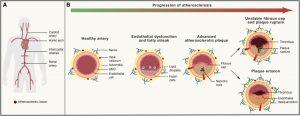Inflammation is now recognised as a central force behind the entire course of atherosclerosis (Figure 1), from its earliest vascular changes to life-threatening complications such as heart attack and stroke. In a new study, researchers synthesise decades of discovery revealing how misdirected immune and vascular responses fuel disease progression and how this growing mechanistic understanding is reshaping cardiovascular therapy.
Arteries are dynamic organs, not inert conduits. Endothelial cells lining their inner walls continuously sense blood flow, respond to injury, and interact with immune cells. When exposed to stressors such as hypertension, high cholesterol, or elevated blood sugar, endothelial regions that experience disturbed blood flow become prone to plaque formation. Over time, immune cell infiltration and chronic inflammation in these regions drive lesion growth and instability, leading to ischemic heart disease, stroke, and peripheral artery disease.
The review highlights how classical cardiovascular risk factors converge in the bone marrow, skewing haematopoiesis toward a pro-inflammatory myeloid output. This results in an increased production of monocytes and neutrophils predisposed to inflammatory activation. Once in circulation, these myeloid cells migrate into atherosclerotic plaques, where they persist, proliferate, and perpetuate local inflammation.
Within plaques, macrophages, the immune system’s key tissue sentinels, emerge as the main conductors of inflammation. They respond to cholesterol accumulation, oxidative stress, and dying cells, producing cytokines that further amplify inflammatory cascades and promote plaque instability.
The review also traces how insights into cytokine biology, particularly interleukin-1β (IL-1β) and interleukin-6 (IL-6), have transitioned from bench to bedside. Large-scale clinical trials such as CANTOS (targeting IL-1β) and others focused on IL-6 signaling have validated inflammation as a modifiable risk factor in atherosclerosis, reducing cardiovascular events independent of cholesterol levels.
Emerging therapies now aim to target the inflammatory arm of atherosclerosis more precisely, complementing lipid-lowering and antihypertensive strategies. These include agents that modulate myeloid cell activation, reprogram hematopoietic stem cells, or block key inflammatory mediators upstream of IL-1β and IL-6.
Ultimately, the review underscores a paradigm shift: atherosclerosis is not merely a lipid storage disorder, but a chronic immuno-inflammatory disease rooted in dysregulated communication between the vascular system and the immune system. Understanding and therapeutically recalibrating this dialogue, starting from the bone marrow to the arterial wall, offers a path toward reducing the global burden of cardiovascular disease.
Journal article: Libby, P., et al., 2025. Inflammation in atherosclerosis: Lessons and therapeutic implications. Immunity.
Summary by Stefan Botha











